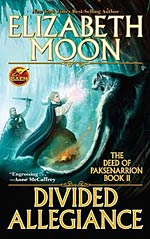
![]() Sable Aradia
Sable Aradia
9/19/2016
![]()
Read for the Women of Genre Fiction Challenge and the High Fantasy Reading Challenge.
This is the second book in The Deed of Paksenarrion trilogy, and like most second books, this one ends on the sharpest cliffhanger and with the hardest ending.
I have to say that I wasn't as fond of this one as I was of the first one in the series, and that's unusual for me. Normally in a trilogy like this, the dramatic tension is greatest in the second book and the most riveting. But this one left me floundering in some places.
Judith Tarr wrote (featured on the cover of the original pocket book edition) that "This is the first work of high heroic fantasy I've seen that has taken the work of Tolkien, assimilated it totally and deeply and absolutely, and produced something altogether new and yet incontestably based on the master." But I think that must be because Judith Tarr never played Dungeons & Dragons. It's clear to me, as a veteran RPG gamer (the real kind, where you actually roleplay at a table with dice,) that Moon's concept--which is admirable and of which I wholeheartedly approve--was to take a standard Dungeons & Dragons 1st edition plot and adventuring party, and try to imagine how such things might actually fit in a real world where real people do real things and react in real ways; where physics and logistics work; and where what we would call "game effects" have "roleplaying effects" that go beyond what you can normally do in a game. If you doubt me, consider this: a fighter, an elf, a dwarf, a priest, a mage and a paladin set out from the paladin's stronghold on a quest to find sacred sites and ancient artifacts of the paladin's holy order. They encounter evil elves who live underground, worship an evil spider-goddess, and who keep orcs and dog-headed beings that the protagonist couldn't name for slaves (gnolls). I won't reveal the rest of details of the plot because that would be heavy on the spoilers, but I will say that much of the magic and the good and evil powers work like D&D magic and powers. Gird, to me, is almost exactly like St. Cuthbert. And actually, I think all of this is great. The next time someone sneers at me about how no one wants books based on RPGs because they're garbage, I will simply say, "The Deed of Paksennarrion" and fold my arms.
Because it's good! I didn't like it as much as the first one simply because of a matter of style. I felt that Moon did a lot of telling and not showing in the bulk of the book, as though the only actually important part of the plot was the encounter with the evil elves, and the rest of the book was just explaining the setup for it. It didn't have as much of the logistical sort of realism that I loved in Sheepfarmer's Daughter, either. Also, I was a bit disappointed by how the first few pages of this book seemed to work immediately to undue the story arc that had resolved itself in the first book. I could tell that the resolution of the first book was not going to last because of some lingering doubts and chance encounters thrown in that otherwise would have served no purpose, but I expected Moon to take longer to unravel it. Almost all of the story that was resolved in the first book was undone in the first two chapters of this one. It almost had a feel like a dream sequence in which the protagonist dies, which is later revealed to be just a dream sequence. It felt like cheating to me.
But don't give up on it yet, because Moon did a couple of excellent things with this book that I think we need more of in high fantasy. The first is that even magical healing is not simple. The second is that even paladins can suffer from post traumatic stress disorder, which is treated like a true battle wound but is little understood except by the most experienced soldiers and war-leaders. And the third is that a black-and-white, simplistic view of good and evil, is represented as not being a true understanding of the nature of good and evil, and things are much more grey than a typical such heroic fantasy would have us believe. Oh yes; and lastly, henchmen are real people with their own needs and motivations and personalities and names.
I suspect I'll have more to say once I've read the conclusion, since this was evidently written as one story in three parts. And it certainly did the job, because I immediately picked up the third book once I had finished this one, and was grateful I'd had the foresight to collect the whole series before I started reading it.